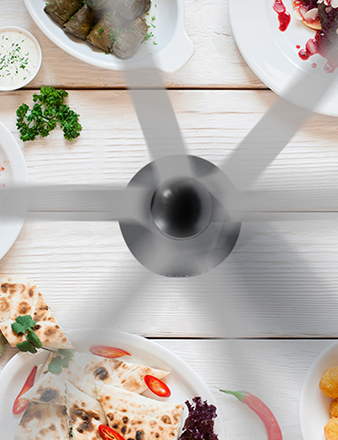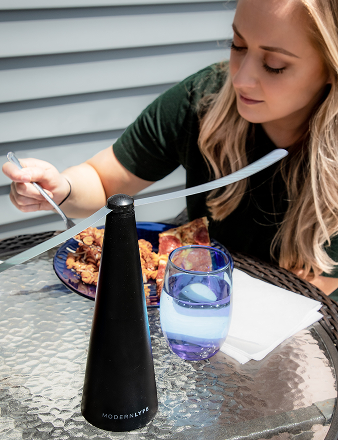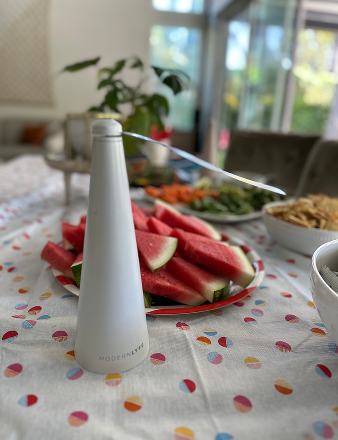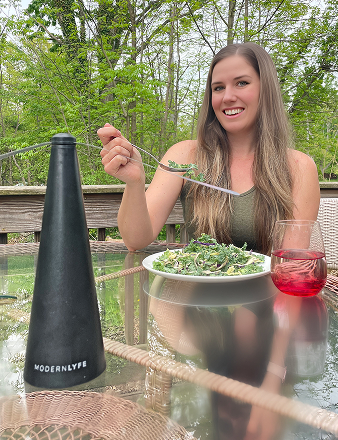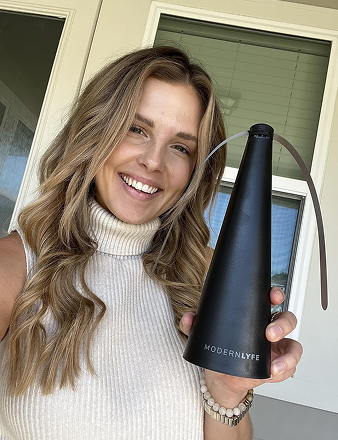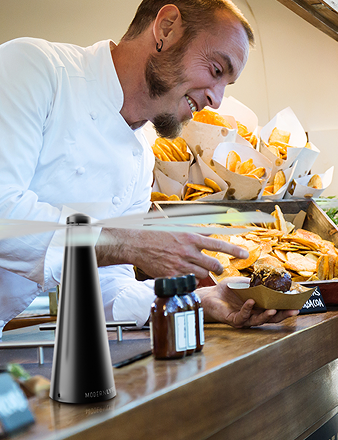You've planned the perfect backyard barbecue. The food is grilled to perfection, the guests are laughing, but you're stuck shooing away flies. It's more than annoying—it's a health risk. This is where modern fly covers for food make all the difference, turning a potential pest problem into a stress-free meal.
Why Flies at Your Table Are a Bigger Deal Than You Think
We've all been there. But when you're hosting, flies aren't just a nuisance; they're carriers for germs and bacteria.
When a fly lands on your food, it can deposit pathogens like Salmonella and E. coli. That delicious meal suddenly becomes a gamble with foodborne illness. Whether you're dining outdoors, setting up an indoor buffet, or having a picnic, keeping your food covered is non-negotiable for safety.
Why Food Protection Is Essential
This isn't just about avoiding a minor irritation. It's about creating a clean, safe, and enjoyable environment for your guests. No one wants to spend their meal on high alert, guarding their plate.
This growing awareness around hygiene has increased the demand for better pest control. The global market for fly traps was valued at USD 357.6 million in 2022 and is projected to grow, showing that people are getting serious about preventing contamination.
Using fly covers for food is about securing peace of mind. It’s the freedom to enjoy good food and great company, knowing your meal is protected.
Ultimately, keeping flies off your food is a fundamental part of good hosting. You can find more tips in our guide on how to keep flies away from food. Fortunately, we've moved past flimsy mesh nets to smarter, more reliable solutions for this age-old problem.
Why Traditional Food Covers Don't Work
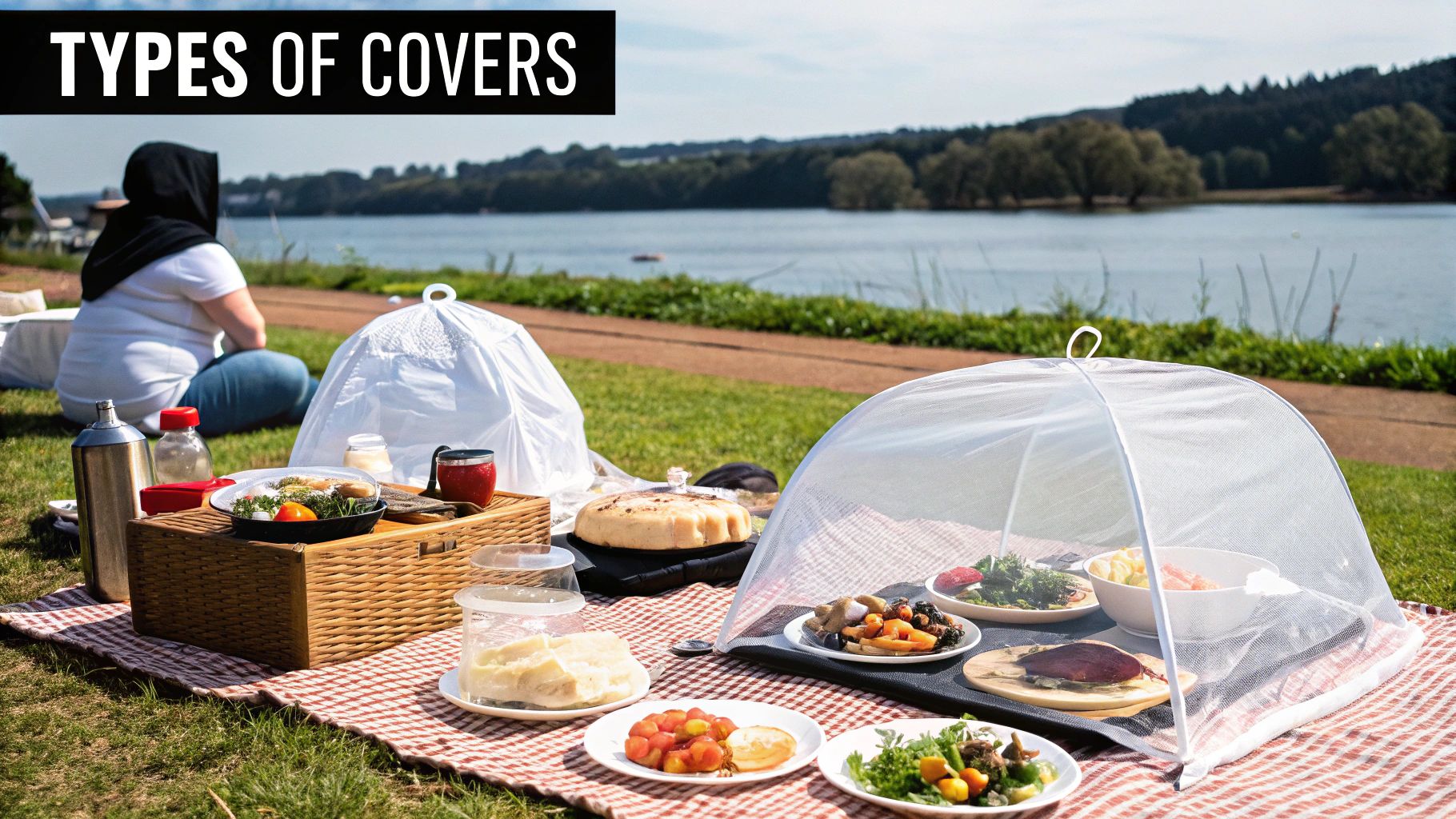
We all know the classic mesh food tents from family picnics and barbecues. But let's be honest—these traditional fly covers for food are often more trouble than they're worth.
Think about the last buffet line you were in. Someone is always doing the awkward one-handed lift of a flimsy cover while trying to serve themselves. It's a clumsy process that slows everyone down and makes accessing food a hassle.
This approach is entirely passive. The covers are just a stationary barrier that does nothing to stop flies from swarming nearby. The second someone lifts the lid, pests dive straight for the food.
The Inevitable Trapped Fly
Even worse is when a fly gets trapped underneath the cover as you're putting it down. Now, instead of a food protector, you have a tiny greenhouse for a very happy insect. It’s a frustrating and unhygienic situation that defeats the purpose.
Old methods aren't designed for the dynamic flow of a real meal. They offer a false sense of security but provide almost no defense against a determined bug.
The biggest issue with old-school food covers is their passive nature. They require constant management and fail the moment you need to serve the food they're meant to protect.
This turns what should be a relaxing get-together into a tactical mission of guarding food and fumbling with covers, taking away from the enjoyment.
Common Issues with Traditional Covers
Beyond the trapped fly and awkward serving, these old solutions are simply outdated. They're often bulky, hard to clean, and the delicate mesh tears easily.
Here are a few more reasons why they don't measure up:
- Limited Coverage: A single mesh tent might cover one dish, but what about a full spread? You end up needing an army of them, cluttering the entire table.
- Wasteful Disposables: Using plastic wrap or foil isn't a great alternative. It’s single-use and contributes to the estimated 1.4 billion pounds of plastic film that ends up in landfills each year.
- Poor Aesthetics: A jumble of mismatched plastic lids and saggy nets doesn't complement your food presentation. They can make an otherwise beautiful setup look cheap and messy.
These frustrations all point to one conclusion: we need a better, more active way to handle pests. It's time for a solution that protects our food without getting in the way.
The Modern Solution: Fly Fans
It’s time to talk about the game-changer in food protection: the fly fan. Forget clumsy, passive covers. A fly fan is a quiet, invisible force field for your dining table, offering an active defense that keeps pests away automatically.
How does it work? The concept is brilliantly simple.
The device uses soft, rotating blades to create a gentle, persistent air current around your food. While you'll barely notice this unpredictable breeze, it's a nightmare for a fly.
Flies see through thousands of tiny lenses in their compound eyes, making them extremely sensitive to motion and light. The reflective patterns on the fan blades, combined with the disruptive airflow, completely disorient them. They perceive the area as chaotic and unsafe, so they steer clear and leave your food alone.
Why Fly Fans Are the Smarter Choice
Unlike a mesh tent that can trap a bug with your food, a fly fan creates a continuous "no-fly zone." This active approach means you can serve food, talk with guests, and enjoy your meal without worrying about a fly landing on your plate.
The design is centered on convenience and safety. Most are battery-powered and portable, so you can place them anywhere you need protection—from a picnic blanket to a large buffet table. This flexibility makes them one of the most effective fly covers for food available today.
A key feature of well-designed fly fans is soft-stop blade technology. If your hand or a child's finger touches the blades, they stop spinning immediately, making them perfectly safe for any gathering.
Key Features of a Modern Fly Fan
These devices are packed with features that make them a superior choice for protecting food and improving your dining experience. They solve all the common problems of traditional covers.
What makes them so effective?
- Chemical-Free: They keep pests away using only air movement. That means no toxic sprays or chemicals near your food.
- Quiet and Unobtrusive: The motors are designed to be whisper-quiet, so they won’t interrupt conversations or add distracting noise.
- Sleek and Stylish: Ugly nets can ruin a nice table setup. Modern fly fans are designed to look good and complement your decor.
For a deeper look at how these devices work, you can learn more about the science behind the fly fan and see why they have become an essential tool for modern hosts.
Comparing Your Food Protection Options
When it comes to keeping flies off your food, your options aren't created equal. The right choice isn't just about covering a plate; it's about finding what actually works in a real-world social setting. A side-by-side comparison tells the whole story.
Classic fly covers for food, like mesh pop-up tents or plate lids, are "passive" protectors. They create a physical barrier, which works until someone wants food. The moment you lift the cover, it’s an open invitation for every nearby fly to dive-bomb the dish.
Modern fly fans offer an active approach. Instead of a static barrier, they create a gentle breeze that disorients flies and disrupts their flight path, causing them to avoid the area. This means your food is both protected and accessible—no more fumbling with clunky lids.
Whether you use a simple cover or an advanced device, the goal is to keep food fresh and hygienic.
Fly Covers for Food: A Head-to-Head Comparison
To see which solution is best, let's compare them on the features that matter most when you're hosting. This table breaks down traditional covers versus modern fly fans.
The differences in effectiveness, ease of use, and aesthetics are stark.
| Feature | Mesh Food Tents | Plate Covers | Modern Lyfe Fly Fans |
|---|---|---|---|
| Effectiveness | Low: A passive barrier that often traps flies inside and is useless when serving. | Low: Only covers individual dishes and requires constant removal and replacement. | High: Creates an active "no-fly zone" that keeps pests away continuously. |
| Ease of Use | Poor: Awkward to lift with one hand; clumsy for guests to navigate. | Poor: Clutters the table and requires juggling lids while serving food. | Excellent: Set it and forget it. Provides hands-free protection for the entire table. |
| Safety | Good: No moving parts, but offers no real protection from contamination. | Good: Simple and safe, but provides very limited and impractical coverage. | Excellent: Features soft-stop blades that are completely safe for kids and pets. |
| Aesthetics | Poor: Often look cheap, flimsy, and can ruin a well-set table's appearance. | Fair: Can look disorganized and cluttered when multiple covers are used. | Excellent: Sleek, modern design that complements any table setting. |
This breakdown clearly shows why so many people are switching to a modern approach for their gatherings.
The Clear Winner for Modern Gatherings
The chart makes it obvious: fly fans have a clear edge. While old-school covers provide a basic shield, they fail when it comes to practicality and user experience, adding hassle to what should be a relaxed event.
Fly fans, especially well-designed models from Modern Lyfe, are built for how people actually entertain. They don't just cover your food; they actively defend the entire area without getting in the way. For backyard barbecues, outdoor dinners, or indoor buffets, a fly fan is an investment in better hygiene, convenience, and peace of mind.
To learn more about the science, explore our full guide on how effective fly fans really are for a complete breakdown.
How to Use Fly Fans for Any Occasion
A fly fan is a simple tool, but smart placement is key to maximizing its effectiveness. A little planning can create a perfect, pest-free zone exactly where you need it.
For a standard round or square table seating four to six people, one fan placed in the center is usually enough. Its rotating blades create a 360-degree protective zone that covers everything—perfect for family dinners on the patio or casual get-togethers.
Mastering Different Setups
For larger tables or different layouts, adjust your strategy. Different events require different setups to keep every dish protected.
-
Long Rectangular Tables: For a large buffet line or a long family-style table, one fan won't be enough. Place one fan at each end to create overlapping air zones that leave no gaps for flies.
-
Intimate Picnics: On a picnic blanket where space is limited, a single, compact fly fan placed in the middle of your food will do the job perfectly without taking up too much room.
-
Outdoor Commercial Patios: Restaurant and café owners can place one fan on each small table to protect individual meals. For larger communal tables, use two fans to ensure every customer can dine pest-free.
This targeted approach is more than just convenient; it's a public health measure. Flies carry germs that cause foodborne illnesses, and demand for effective fly control is growing. The North American market is seeing rapid growth in related sectors at a 13.9% CAGR, driven by new regulations and incentives. You can find more data on the insect control market at Mordor Intelligence.
Placement Rule: The fan's airflow should cover the food, not the guests. Create a barrier directly over the dishes to keep air moving where it matters most.
Pro Tips for Optimal Coverage
Want to get the best performance from your fly fan? A few simple tricks can guarantee a fly-free zone.
If you're using a tiered serving platter, place the fan on the top level. Gravity will help the air flow downwards, protecting all the layers below. Thoughtful placement like this ensures you can host any event with confidence, knowing every dish is clean and safe.
Elevate Your Dining Experience Beyond Protection
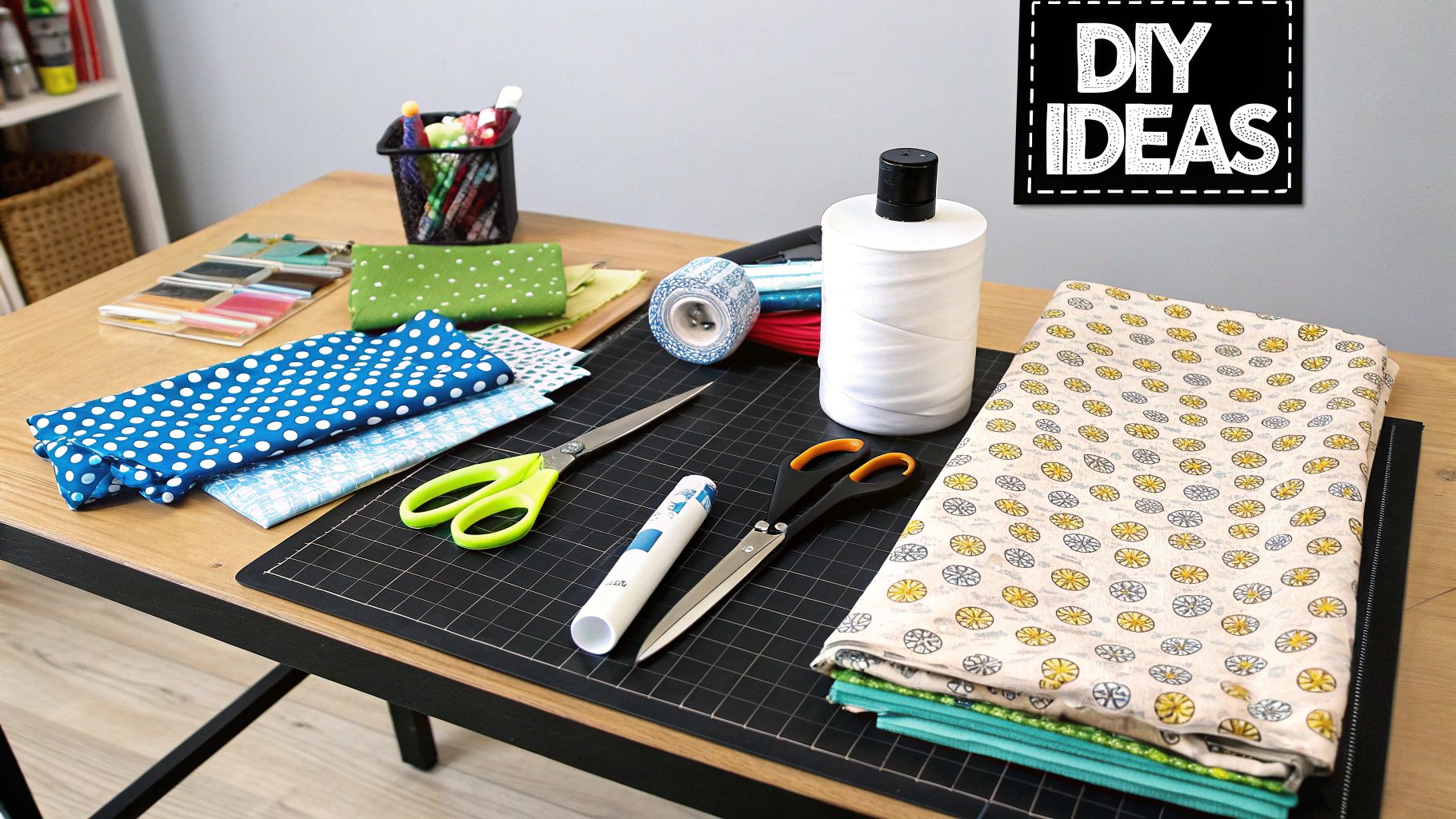
True hospitality is about more than just great food. It's about creating an atmosphere where guests can relax and connect. While hygiene is a key reason to use fly covers for food, the biggest benefit is the effortless peace of mind they provide.
When you remove the stress of swatting at pests, the entire dynamic shifts. Conversations flow more freely. Laughter comes easier. The focus returns to what matters: good food and great company. You can finally stop being a stressed-out host and become part of the fun.
The Freedom to Simply Enjoy
Imagine a summer barbecue where you're not hovering over the food with a napkin. Picture a picnic where the only thing on your mind is which dessert to try next. That’s the freedom you get with modern food protection.
It turns your dining area into a sanctuary, letting everyone savor each bite without interruption. Keeping your food safe becomes a seamless background detail you don't have to think about.
The goal is to create an experience so smooth that your guests don't even notice the protection. They only notice how pleasant and comfortable the meal is—the hallmark of great hosting.
This small change elevates your entire event from a simple meal to a cherished memory. Choosing a smart solution like a Modern Lyfe fly fan isn't just buying a gadget; it's investing in better quality time with the people you care about. It’s an essential tool for anyone who believes a good meal is one of life’s greatest pleasures.
Still Have Questions About Fly Fans?
It's smart to ask questions before bringing a new device to your table. When it comes to active fly covers for food like fly fans, the biggest concerns are usually safety, coverage, and effectiveness. Let's tackle the most common ones.
Are the Blades Safe Around Kids and Pets?
This is the top question, and it's an important one. The idea of spinning blades near small hands or curious pets is a valid concern. The answer is yes, they are completely safe.
Reputable fly fans are designed with safety as a priority. The blades are made from a soft, flexible material that is harmless on contact. More importantly, they include a safety-stop mechanism. The instant a blade touches anything—a hand, a napkin, or food—it immediately stops spinning, making them a worry-free addition to any gathering.
How Many Do I Need, and What Pests Do They Stop?
So they're safe, but how many do you need? It depends on your table size, but the guideline is simple.
- Standard Tables: For a typical round or square table seating four to six people, one fan in the center is sufficient. It creates a 360-degree no-fly zone.
- Long Tables: For a long buffet or a large rectangular dining table, place one fan at each end. This creates overlapping protection, leaving no gaps for pests.
You might also wonder if these fans only work on flies. While they are designed to disrupt a fly's vision, the constant, gentle breeze is also a deterrent for other flying insects like mosquitoes, wasps, and gnats.
The unpredictable airflow makes it difficult for most small insects to land, keeping your entire dining area more comfortable and pest-free.
Ready to enjoy a meal without swatting? Check out the elegant and effective fly fans from Modern Lyfe. It's the easiest way to add modern protection to your food.

